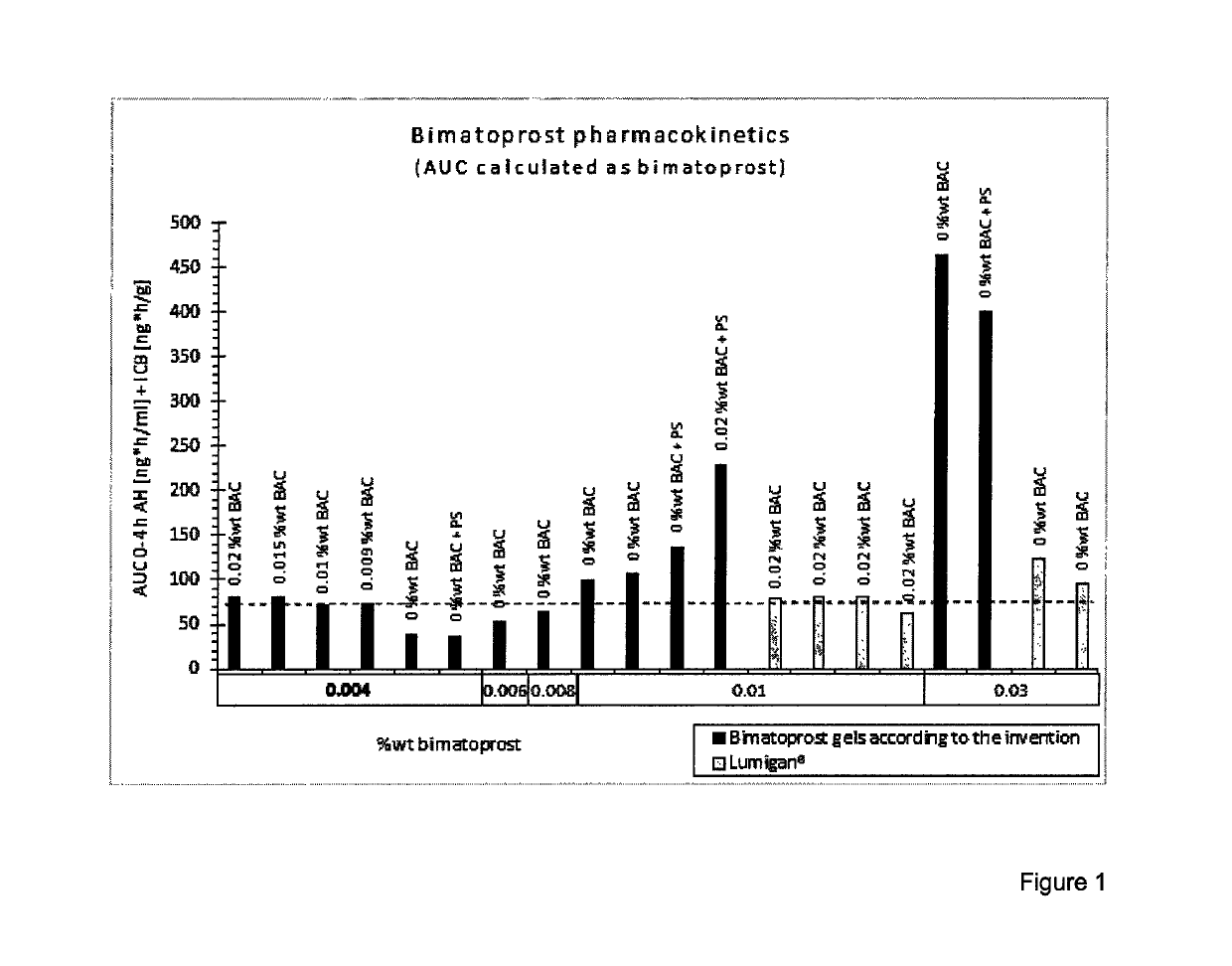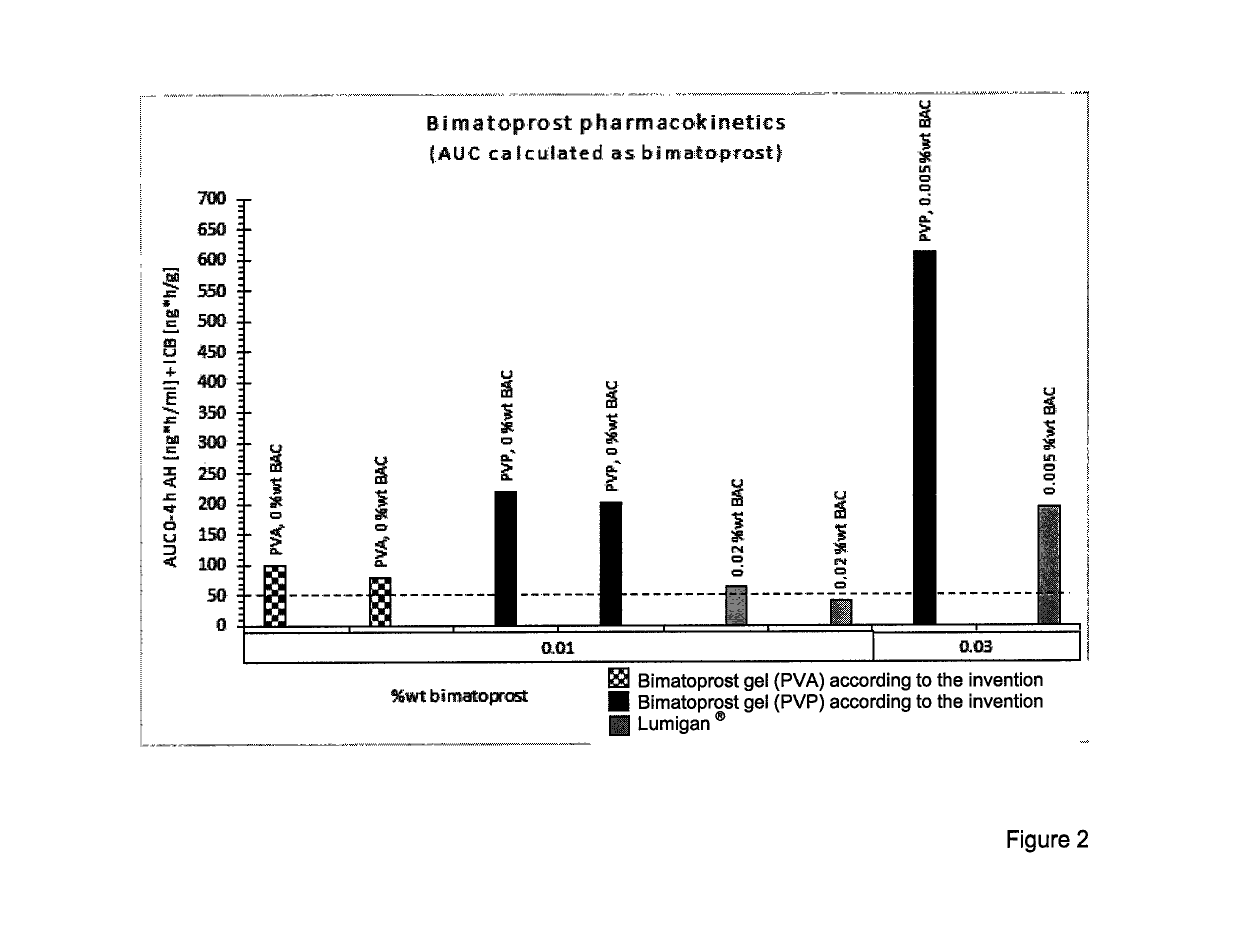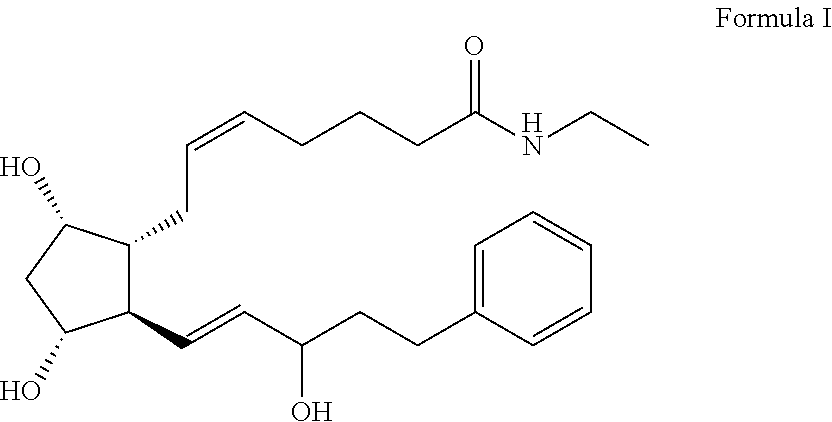Drippable opthalmic bimatoprost gel
a technology of opthalmic bimatoprost and ophthalmic bimatoprost, which is applied in the directions of drug composition, sense disorder, and delivery of aerosols, can solve the problems of well-known ingredients already used, and achieve the effect of improving the
- Summary
- Abstract
- Description
- Claims
- Application Information
AI Technical Summary
Benefits of technology
Problems solved by technology
Method used
Image
Examples
example 2
[0064]Unpreserved bimatoprost 0.004% gel containing poly(vinyl alcohol):[0065]Solution A: Dissolve 0.8 g poly(vinyl)alcohol in 15.2 g purified water by heating to 95° C. while mixing.[0066]Solution B: Dissolve 0.5 g trometamol in 10 g purified water.[0067]Solution C: Dissolve 4 mg bimatoprost, 50 μl polysorbate 80, 2.4 g glycerol, 0.22 g sodium acetate·3 H2O in 45 g purified water, and finally disperse 0.35 g carbomer.
[0068]Combine Solution C with Solution A, then add Solution B and complete with purified water to the final weight of 100.0 g. Mix during 30 minutes. Autoclave the mixture for 20 min at 121-124° C. Use vacuum degassing equipment, if necessary to obtain a bubble-free gel.
[0069]The gel is clear, transparent and uncoloured, has a pH of 7.30, a viscosity of 422.5 mPa·s, and an osmolality of 295 mosm / kg.
example 3
[0070]Preserved bimatoprost 0.004% gel containing povidone:[0071]Solution A: Dissolve 4.0 g povidone and 1.02 g trometamol in 40 g purified water.[0072]Solution B: Dissolve 8.4 mg bimatoprost (5% overage) in 5 g purified water.[0073]Mixture C: Dissolve 0.37 g sodium acetate·3 H2O, 4 ml benzalkonium chloride 1% solution, and 4.6 g glycerol in 80 g purified water, then disperse 0.7 g carbomer. Use a total of 10 g purified water in suitable portions to rinse the containers during the addition steps. Agitate the mixture during 30 minutes, then autoclave Mixture C for 20 min at 121-124° C.[0074]Preparation of the finished gel: Add Solution B to Mixture C through a sterile membrane filter (pore size 0.22 μm), rinse with purified water, then add Solution A through a sterile membrane filter (pore size 0.22 μm), rinse with purified water; use a total of 30 g purified water divided in suitable portions to rinse the containers and membrane filters during the addition steps. Eventually complete...
example 4
[0077]Unpreserved bimatoprost 0.004% gel containing polyvinylpyrrolidone:[0078]Solution A: Dissolve 4.0 g povidone and 1.02 g trometamol in 30 g purified water.[0079]Solution B: Dissolve 8.4 mg bimatoprost (5% overage) in 5 g purified water.[0080]Mixture C: Dissolve 0.37 g sodium acetate·3 H2O, and 4.6 g glycerol in 80 g purified water, then disperse 0.7 g carbomer. Use a total of 10 g purified water in suitable portions to rinse the containers during the addition steps. Agitate the mixture during 30 minutes, then autoclave Mixture C for 20 min at 121-124° C.[0081]Preparation of the finished gel: Add Solution B to Mixture C through a sterile membrane filter (pore size 0.22 μm), rinse with purified water, then add Solution A through a sterile membrane filter (pore size 0.22 μm), rinse with purified water; use a total of 30 g purified water divided in suitable portions to rinse the containers and membrane filters during the addition steps. Eventually complete the procedure with purifi...
PUM
| Property | Measurement | Unit |
|---|---|---|
| viscosity | aaaaa | aaaaa |
| concentration | aaaaa | aaaaa |
| concentration | aaaaa | aaaaa |
Abstract
Description
Claims
Application Information
 Login to View More
Login to View More - R&D
- Intellectual Property
- Life Sciences
- Materials
- Tech Scout
- Unparalleled Data Quality
- Higher Quality Content
- 60% Fewer Hallucinations
Browse by: Latest US Patents, China's latest patents, Technical Efficacy Thesaurus, Application Domain, Technology Topic, Popular Technical Reports.
© 2025 PatSnap. All rights reserved.Legal|Privacy policy|Modern Slavery Act Transparency Statement|Sitemap|About US| Contact US: help@patsnap.com



